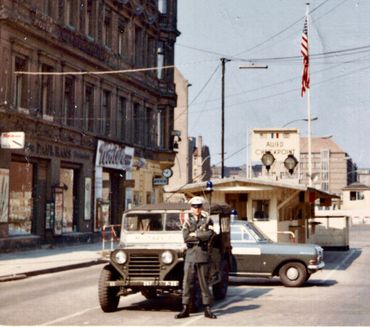
Berlin Photos
Stan Nelms served as a Military Policeman with the 287th MP Company, Berlin Brigade in 1966
Checkpoint Charlie





.jpeg/:/rs=w:370,cg:true,m)




And Now it's a Museum
Along the Wall
Steinstücken
Steinstücken was a village a few miles SW of Berlin inside East German territory. Since it was a part of the American sector it required a presence of three MPs to enforce the terms of the Four-Power Agreement; thereby keeping the residents safe from the thousands of Soviet and East German troops surrounding them.

Steinstücken History
At the end of World War II in 1945, West Berlin's city boundary became the dividing line between the Soviet zone of Germany and the American, British and French sectors of Berlin. For the first couple of years, the border still remained open. An escalation of the Cold War (the Berlin Blockade and the proclamation of two separate German states) turned Berlin's outer boundary into a part of the Iron Curtain, and thus Steinstücken into an island of West Berlin, itself an island, in East Germany. In 1951, the GDR attempted to annex Steinstücken by sending police and military forces into the exclave. After objection by the United States, they withdrew their forces a few days later. After this event, access of the inhabitants into surrounding East Germany was prohibited. From then on their only access to the outside world was through two East German checkpoints and a road of about 1 km length into West Berlin proper. For all their everyday activities (e.g. work, school, shopping, visits of friends and relatives) they had to pass these controls from then on. After the building of the Berlin Wall in 1961, Steinstücken became the focus of several escape attempts; as a tiny exclave within East German territory it was demarcated only by barbed wire barriers. After more than twenty East German border guards escaped to the west through Steinstücken, the communist regime in East Germany built a wall around Steinstücken to cut off this escape route. Following a visit by Lucius D. Clay on September 21, 1961, by helicopter, a US military post was installed in the exclave. Soldiers were regularly flown in by helicopter from then on. Today, a "helicopter memorial" commemorates these circumstances.




















.jpeg/:/rs=w:370,cg:true,m)

















.jpeg/:/cr=t:0%25,l:0%25,w:100%25,h:100%25/rs=w:370,cg:true)
.jpeg/:/rs=w:370,cg:true,m)